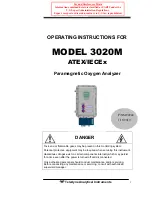
3 Operating Instructions
Rev: 1.0, 15-Mar-2021
Page 12
3.2.7 UART Operation
The PM103 is delivered in RS232 operation but can be switched to UART operation.
UART dependent PM103 functions:
The PM103 may need to be switched from RS232 to UART operation when using an external
micro controller for PM103 control. In RS232 operation the PM103 uses voltage levels of +/-5
V, while in UART mode the voltage level is shifted to 0/5 V. The PM103 can also be adjusted to
accommodate micro-controllers using 3.3 V. When switched to 3.3 V, UART operation is toler-
ant for 5 V input signal.
For instructions on how to change the voltage level for UART operation, please refer to the doc-
ument Write-Your-Own-Applications (WYOA) for PM103x.
For UART operation, please use standard protocols for UART communication and the SCPI
commands listed in WYOA for PM103x.
3.2.8 Reset Button
The
reboots the internal micro controller of the PM103x. To press the button,
please use a small device that will not break inside the instrument. All settings are saved due to
the internal non-volatile memory.
3.2.9 Baud Rate
For PM103, the Baud Rate can be adjusted from 9600 to 230400 Bit/s. This can be done either
via the USB interface or via the serial interface using SCPI commands or driver functions.
Please see the document Write-Your-Own-Applications (WYOA) for PM103x. The default Baud
Rate is 115200.
Note
After adjusting the Baud Rate via RS232 or UART, close the RS232 or UART connection and
reconnect with the desired Baud Rate in order for the Baud Rate to communicate it via
RS232/UART. This is not required for operation via USB.
3.2.10 Non-Volatile Memory
All PM103x models have an internal non-volatile memory for all settings (i.e. wavelength set-
ting, ranging, analog output configuration). The PM103x will start in the same configuration as
prior to shut-down.
3.2.11 Digital I/O Ports
PM103
The PM103 has two configurable gerneral purpose digital ports, DIO1 (
) and
DIO2 (
). Both ports can be configured as digital input or output and queried per
remote control command. These digital I/O ports use 3 V logic for output and are tolerant for 5
V input signal.
DIO1 can additionally be configured as trigger in and output, when reading the data in the 100
kS/s mode. The trigger function is supported by the Optical Power Monitor software. Alternat-
ively, the DIO1 port can be controlled or monitored through SCPI commands in custom made
software, as described in the document WYOA for PM103x.
DIO2 can be configured as pass/fail analysis flag and queried per remote control command.
8
20
20
















































